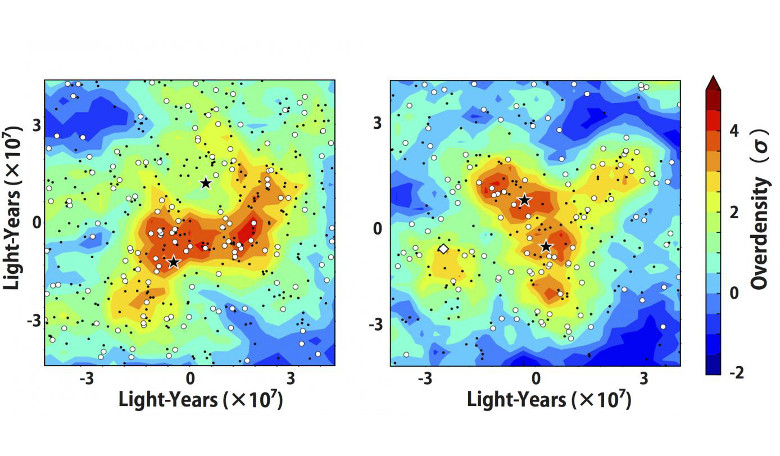After a survey of nearly 200 regions to analyse protoclusters and quasars, researchers are having to think twice about the relationship between galaxy formation and how these massive and extremely remote celestial objects that surround black holes are formed.
Throughout the Universe, galaxy distribution is far from uniform. Some galaxies are rather isolated, whereas others gather in big numbers (over a hundred) to form clusters. While the exact definition of what a protocluster actually is has yet to be agreed upon, it is generally used to refer to a group of very young galaxies that will merge together to form a galaxy cluster.
Despite their huge size, protoclusters are notoriously difficult to find because young, distant galaxies are very faint. Indeed to date only around 20 were previously known about.
Quasars on the other hand consist of a supermassive black hole surrounded by an orbiting accretion disk of gas. They are among the most luminous, powerful, and energetic objects known in the universe, emitting up to a thousand times the energy output of the Milky Way and historically, they were thought to inhabit the very centre of active, young galaxies.
This apparently symbiotic relationship was a boon for researchers as quasars swiftly became the default object in which to help pin down the location of these dim and distant protoclusters from 12 billion years ago.
Now however, a team including astronomers from the National Astronomical Observatory of Japan (NAOJ) have conducting an unprecedented wide-field systematic survey of protoclusters using the Subaru Telescope's very wide-field camera, Hyper Suprime-Cam (HSC) and found that things might not be as they seem after all.
After sampling 151 luminous quasars from the same epoch as the HSC protoclusters, the team found to their surprise that most of those quasars are not close to the overdense regions of galaxies at all. In fact, quite the opposite as most of the luminous quasars appear to avoid the densest regions of galaxies.
These results suggest therefore that mechanisms other than galactic mergers may be needed to explain quasar activity. Furthermore, since the team did not find many galaxies near the brightest quasars, that could also mean that hard radiation from a quasar suppresses any surrounding galaxy formation.
Not only that, but when the team did find quasars residing in protoclusters, they found them as ‘pairs’ - two ‘pairs’ to be precise. Quasars are rare and pairs of them are even rarer.
"We have succeeded in discovering a number of protoclusters in the distant Universe for the first time and have witnessed the diversity of the quasar environments thanks to our wide-and-deep observations with HSC," says the team's leader Nobunari Kashikawa from the NAOJ.
"The HSC protoclusters will steadily increase as the survey proceeds. Thousands of protoclusters located 12 billion light-years away will be found by the time the observations finish,” added Jun Toshikawa, lead author of the a paper reporting the discovery of the HSC protoclusters.
Hopefully, with those new observations researchers will be able to clarify the growth history of protoclusters and how quasars fit into the equation.











